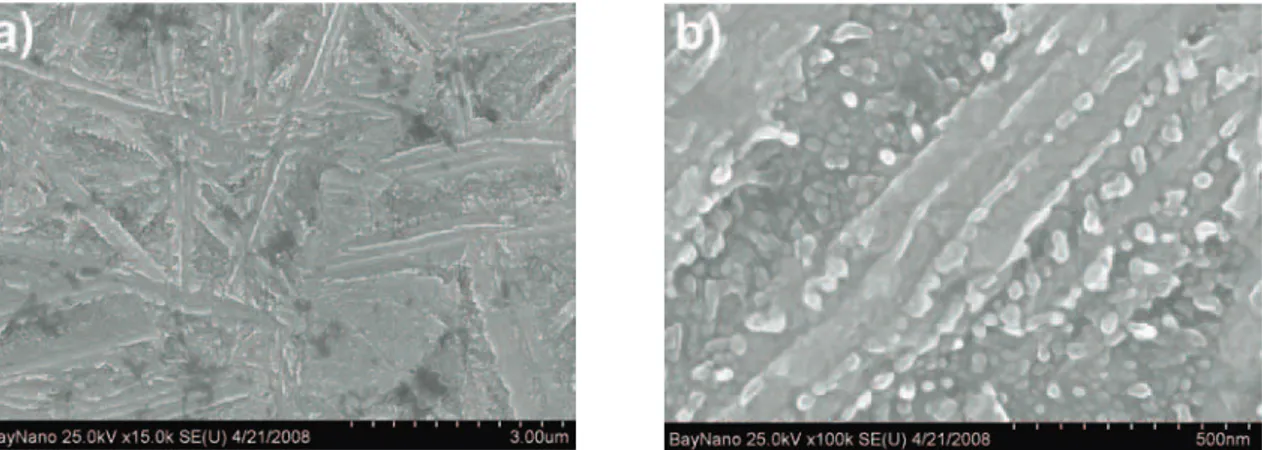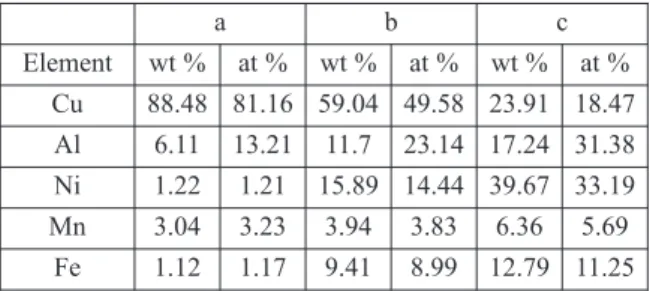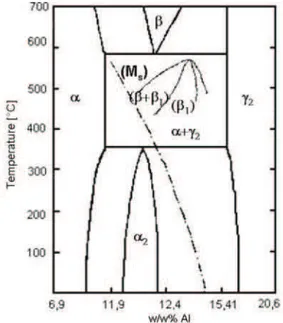INVESTIGATION OF THE BAINITIC REACTION IN A CuAlNiMnFe SHAPE
MEMORY ALLOY
M. Benke a, #, V. Mertinger a, P. Pekker b
aUniversity of Miskolc, Institute of Material Sciences, Miskolc, Hungary
bUniversity of Miskolc-Hungarian Academy of Sciences Research Group, Miskolc, Hungary
(Received 01 August 2012; accepted 04 October 2012)
Abstract
Despite their favorable properties, brittle nature of the CuAlNi shape memory alloys limits their suitability. To increase their ductility, Mn and Fe were added to the base CuAlNi alloy. To reveal the applicability of the developed CuAlNiMn and CuAlNiMnFe alloys as functional materials, the effect of ageing on the thermoelastic martensitic transformation was investigated. During the first heating of the aged samples the thermoelastic γ’ → β transformation occurred, which was followed by a bainitic transformation. This transformation inhibited the further thermoelastic martensitic transformations. The present paper covers heat flux DSC, SEM, and TEM investigations of the bainitic transformation. A feasible mechanism of the bainitic transformation in these alloys is suggested based on the results of the examinations.
Keywords: CuAlNiMnFe; Shape memory alloy; Bainitic reaction.
* Corresponding author: martonbenke81@gmail.com
S e c t i o n B : M e t a l l u r g y
DOI:10.2298/JMMB120801003B 1. Introduction
CuAlNi based shape memory alloys (SMAs) have favorable transformation characteristics (such as high transformation temperatures) and low price compared to TiNi and other compounds. The ageing effects in the martensite and the austenite phases and the related transitions are well described in many CuAlNi based shape memory alloys [1-10]. However, the brittle behavior of the CuAlNi alloys resulting from the precipitation of the equilibrium γ2 phase and intergranular cracking limit their use. To suppress the eutectoid β1 → α + γ2 decomposition process, and thus, to increase ductility, Mn is a well-known alloying element of the CuAlNi systems. Some papers report that a bainitic transformation occurred in the austenite phase of the CuAlNiMnTi alloys during heating. The “bainitic” term is used in these alloys as well because the principal characteristics of the reaction are similar to the bainitic reactions of steels [11]. The bainitic reaction caused a shift in the transformation temperatures of the thermoelastic γ’ ↔ β1 transformations during the subsequent cooling/heating cycles [12-15]. These papers report about the examinations of alloys with ~2 wt% Mn content.
The ductility of the subject alloys of our investigation was increased by the addition of 4 wt% Mn and 2 wt% Fe to produce CuAlNiMn and CuAlNiMnFe alloys. The aim of our investigation is
to examine the solid state transformation processes in the temperature range of applications of the developed alloys and their effect on the thermoelastic γ’ ↔ β1 transformations. Our previous examinations revealed that an exothermic process occurred in the first heating scan of the betatized, quenched CuAlNiMn and CuAlNiMnFe alloys above the austenite finish (Af) temperature. There was no forward β1 → γ’ martensitic transformation in the subsequent cooling scan. Consequently, there was no reverse γ’ → β1 transformation during the second heating scan. It was concluded that the observed exothermic process destroyed the thermoelastic martensitic transformation. Microstructure examinations revealed that the exothermic process produced a fine plate-like structure containing precipitates which is shown in the CuAlNiMnFe alloy in Fig. 1. a and b [16]. The aim of the present paper is to study the fine structure and the phases produced by the exothermic process and to identify the exothermic process based on our results.
2. Experimental
Slices with ~1.5 mm thickness were spark cut from the rods. The samples were betatized (homogenized) at 1173 K for one hour in an air furnace, then quenched in room temperature water to obtain the γ’ martensitic phase. The quenched samples were then heated to 623 K with 10 K/min in a Netzsch 204 heat flux DSC (Differential Scanning Calorimeter) then subsequently cooled to room temperature with 10 K/min. Ar purge gas was used during the DSC examination. The DSC scans of the first and second heating and cooling runs of alloy B are shown in Fig. 2. The samples were mechanically polished then prepared using ion beam milling for the TEM (Transmission Electron Microscope)
examinations. TEM investigations were performed by a FEI Tecnai G2 device equipped with EDS (Energy Dispersive Spectroscopy) microprobe.
3. Results
Alloys A and B gave similar results during our previous and the present examinations. The only differences between the two alloys were slight differences in the start and finish temperatures of their thermoelastic 2H γ’ ↔ bcc β1 transformations. The start and finish temperatures are known to be very sensitive on the alloy composition and these differences were irrelevant in the characterization of the exothermic process. This suggests that the same process occurs in both alloys. The present paper focuses only on the results of alloy B. Fig. 2. shows the first and second heating and cooling DSC runs of the betatized sample of alloy B. The upper scans correspond to the heating runs while the lower scans correspond to the cooling runs. The black scans correspond to the runs of the first cycle, while the grey scans correspond to the runs of the second cycle.
Figure 1.a) SEM image of the plate-like matrix of the CuAlNiMnFe alloy after the exothermic process. b) precipitates in the matrix [16]
Figure 2. DSC runs of the homogenized sample of alloy B Table 1.Compositions of the examined alloys
Cu [w/w%]
Al [w/w%]
Ni [w/w%]
Mn [w/w%]
Fe [w/w%]
Alloy A rest 10,20 4,92 4,12 0
The direction of the exothermic reaction is also indicated.
It can be seen, that the endothermic peak of the reverse γ’ ↔ β transformation appeared during the first heating run, which was followed by a flat exothermic peak indicating the β → β1 ordering process. There was an exothermic process starting at around 550 K (277°C). There is no forward β1→ γ’ transformation during cooling, furthermore, no transformation was observed during the second cycle. This means that the thermoelastic transformation was killed by the exothermic process. On the other hand, the lack of any heat effect during the first cooling run also means that the structure produced by the exothermic process is preserved after the DSC examination.
The next step was the examination of the fine structure and the phases produced by the exothermic process. The Bright Field (BF) TEM image and the diffraction patterns of the present phases of alloy B are shown in Fig. 3. The locations of the diffraction examinations are also shown.
It can be seen in fig. 3 that the structure produced by the exothermic process consist of a fine plate-like matrix with a few 100 µm in width and fine precipitates with the size of around a few 10 µm. The precipitates are present inside the plates in their centerlines and between the neighboring plates as well. The precipitates in the centerlines are separate and they are following each other in rows. The precipitates at the sides of the plates are grown into each other producing a continuous band. Consequently, the sides of the plates are not straight, they are wavy.
According to the results of the electron diffraction examinations (lattice structure and cell parameter
examinations) the plates are the fcc α (Cu solid solution) phase, while the precipitates are identified as the Al1Ni1 (58037), or Al1Mn0,5Ni0,5 (57978), or Al1Fe0,5Ni0,5(57809) intermetallic phases according to the ICSD (Inorganic Crystal Structure Database) with Pm3-m lattice structure. The Al1Ni1, Al1Mn0,5Ni0,5, and Al1Fe0,5Ni0,5 phases are actually the same intermetallic phase where some of the Ni atoms in the lattice can be replaced by Mn or Fe atoms, or both.
The composition examinations were carried out at the same locations where the diffraction patterns were taken. The results of the composition examinations are summarized in table 2.
The result of the composition examination of the plate (area a) confirmed that the plate is the α phase, that is, Cu solid solution with some content of the alloying elements. The measured composition of the precipitate in the centerline (area b) suggests that the precipitate contains a notable amount of Cu. The Cu content appears in the result of this measurement because the plate surrounding the precipitate was involved in this composition measurement. This disturbing effect could not be eliminated because of the small size of the precipitates. The same effect
Figure 3.Bright Field (BF) TEM image and diffraction patterns of the present phases of alloy B after the exothermic process
a b c
Element wt % at % wt % at % wt % at %
Cu 88.48 81.16 59.04 49.58 23.91 18.47
Al 6.11 13.21 11.7 23.14 17.24 31.38
Ni 1.22 1.21 15.89 14.44 39.67 33.19
Mn 3.04 3.23 3.94 3.83 6.36 5.69
Fe 1.12 1.17 9.41 8.99 12.79 11.25
occurred during the measurement of a precipitate at the side of the plate (area c).
4. Discussion
The fine structure examinations revealed that the exothermic process observed during the first DSC heating run produced a structure consisting of fine α phase plates and (AlNiMnFe) precipitates. It is known that the phase prior to this process is the homogenous β1phase. This means that the exothermic peak is the overall heat effect of a phase transformation and a precipitation process. The two processes cannot be distinguished from each other on the DSC scan. This suggests that the kinetics of the two processes are strongly connected. The results yield that the exothermic process is a bainitic reaction. Bainitic reactions were reported in CuZnAl SMAs as well where the different mechanisms of the bainitic reactions were discussed depending on the alloys composition [17-19].
Let us now discuss the mechanism of this bainitic reaction. The Cu-Al equilibrium phase diagram (fig. 4.) will be used to deduce the probable mechanism. It is true that the binary phase diagram does not deal with the other alloying elements, but Ni, Mn and Fe are concluded to be in solute in the phases (β1, α, and γ’ or β’) of our interest. Furthermore, the binary diagram is used only to understand the mechanism of the observed bainitic reaction. The observed (AlNiMnFe) intermetallic was found to have high Al, Ni, Mn and Fe content compared to the initial composition. The formation of the (AlNiMnFe) intermetallic is not surprising, since one of the stable phases of the Cu-Al system in the composition range of our interest is an intermetallic phase, the γ2phase (besides the α phase). The tendency for the precipitation of the intemetallic phases of the Cu-Al and Cu-Zn based systems was referred and observed in many papers aiming the examination of the precipitation hardening mechanisms of the Cu-Al and Cu-Zn based systems [20]. While the formation of the γ2is suppressed by the Ni content in CuAlNi systems [21, 22], the relatively large amount of the Mn (4 wt %) and Fe (2 wt %) addition evidently aided the formation of the (AlNiMnFe) intermetallic phase. This is confirmed by the fact that using moderate heating rates or annealing temperatures and time the bainitic reaction in the CuAlNiMnFe alloy with ~4 wt% Mn occurred in the whole volume of the sample and the thermoelastic martensitic transformation was completely destroyed, while this reaction occurred only in some regions of the sample in CuAlNiMnTi alloys with ~2 wt% Mn content causing only a shift in the transformation temperatures [12-15].
The plates around the precipitates were found to contain less of the solutes compared to the initial
composition. This is a proof of the depletion of the matrix in solutes. The plates were identified as the equilibrium α phase of the Cu-Al system. However, a relief formation was observed during the bainitic reaction in the CuAlNiMn and CuAlNiMnFe alloys in a previous work of the authors [16]. The relief formation is an evidence of that a martensitic type transformation occurred during the bainitic reaction. If one takes a look at the Cu-Al equilibrium phase diagram it can be concluded that the Ms(Martensite start) temperature is the first to be crossed as the solute concentration of the matrix decreases. The solvus line of the equilibrium α phase is crossed only at lower concentrations. This means that as the growth of the precipitations depleted the β1 matrix, it must have transformed to a martensite (M) first (M is either 18 R β’ or 2H γ’). This can be further confirmed if one considers that the martensitic transformations occur easily in SMAs while the β1→ α transformation involves classical solid state nucleation and growth.
Figure 4. The Cu-Al equilibrium phase diagram
of the the M → α transition it is clear why the α phase was observed instead of the β’ or γ’ phases around the precipitates.
After all, there is no evident proof that the β1→ M transformation occurred first due to the depletion. However, a similar model was suggested for the bainitic reaction in CuZnAl SMAs earlier [18].
It can be easily concluded that the formation of the M plates was driven by the nucleation of the precipitates in the suggested model. The growth of the M plates required the decrease of the solute content in the neighboring β1matrix. This means that the growth of the martensite plates was driven by the growth of the precipitates. Since the formation and growth of the precipitations involve diffusion, the growth of the martensite plates and thus the whole bainitic reaction was controlled by the diffusion. This conclusion is in agreement with results on other Cu-based SMAs exhibiting bainitic reactions [12-14, 17-19].
It was also observed that the rows of the precipitates are parallel with the sides of the plates. The strong directional distribution of the precipitates suggests that the formation of the precipitates was favoured on certain crystallographic planes. Furthermore, the precipitates were also found on the sides of the plates. This suggests that the favoured crystallographic planes are parallel with the habit planes of M. Of course, this suggestion needs further examinations to confirm or confute.
The results of our examinations suggest that the mechanism of the observed bainitic reaction was as follows. Small precipitates of the intermetallic (AlNiMnFe) phase formed in the β1 phase during heating. The formation and growth of the precipitates depleted the surrounding areas of the β1matrix which caused the β1 to transform to a martensite (M). The newly formed β’ or γ’ martensite plates transformed to the α phase by a rapid transition process.
5. Conclusions
After the thermoelastic reverse γ’ → β transformation and the β → β1ordering process took place, a bainitic β1→ (AlNiMnFe) + M reaction was observed during the first DSC heating run in the examined Cu-9.90Al-4.85Ni-4.16Mn-1.92Fe alloy. The bainitic reaction is suggested to have been controlled by the diffusion. After the bainitic β1 → (AlNiMnFe) + M reaction the M → α transition took place.
Due to the β1→ (AlNiMnFe) + M bainitic reaction the CuAlNiMn and CuAlNiMnFe alloys lost their ability for the thermoelastic martensitic transformation. The process started at around 550-600 K depending on the applied scanning rate. The diffusion controlled nature of the process suggests
that this process may occur even at lower temperatures. The high Mn and Fe content resulted an alloy that can not be used as SMA. The effect of Mn and Fe must be taken into account when developing CuAlNi based SMAs.
Acknowledgement
The research was supported by OTKA K 84065 and TAMOP - 4.2.1.B - 10 / 2 / KONV - 0001 - 2010 projects.
References
[1] H. Funakubo, Shape Memory Alloys, Gordon and Breach, New York, 1987.
[2] N. Zarubova, A. Gemperle, V. Novak, J. Phys. IV, France 7 (1997) 281-286.
[3] N. Zarubova, A. Gemperle, V. Novak, Mat. Sci. Eng. A 222 (1997) 166-174.
[4] T. Daricek, J. Lasek, N. Zarubova, V. Novak, P. Bartuska, J. Phys. IV, France 11 (2001) 179-184. [5] V. Pelosin, A. Riviere, J. Alloy. Compd. 268 (1998)
166-172.
[6] V. Recarte, J. I. Perez-Landazábal, A. Ibarra, M. L. No, J. San Juan, Mat. Sci. Eng. A 378 (2004) 238-242. [7] J. I. Perez-Landazabal, V. Recarte, V. Sanchez-Alarcos,
M. L. No, J. San Juan, Mat. Sci. Eng. A, Vols. 438-440 (2006) 734-737.
[8] S. Pourkhorshidi, N. Parvin, M. S. Kenevisi, M. Naeimi, H. Ebrahimnia Khaniki, Mat Sci Eng A 556 (2012) 658-663.
[9] C. E. Sobrero, P. La Roca, A. Roatta, R. E. Bolmaro, J. Malarría, Mat. Sci. Eng. A 536 (2012) 207-215. [10] H. Xu, G. Song, X. Mao, (2011) Adv. Mater. Research,
287-290, (2011) 21-25.
[11] H. K. D. H. Bhadeshia, Bainite in Steels, IOM Communications Ltd., 2001
[12] W. H. Zou, H. Y. Peng, R. Wang, J. Gui, D. Z. Yang, Acta Mater. Vol. 43 (1995) 3009-3016.
[13] Z. G. Wei, H. Y. Peng, D. Z. Yang, C. Y. Chung, J. K. L. Lai, Acta Mater. Vol. 44 (1996) 1189-1199. [14] W. Zou, J. Gui, R. Wang, C. Tang, M. Xiang, D. Zhang,
J. Mater. Sci. 32 (1997) 5279-5286.
[15] U. Sari, T. Kirindi, F. Ozcan, M. Dikici, Int. J. Min Met Mater 18 (2011) 430-436
[16] M. Benke, V. Mertinger, L. Daroczi, www.esomat.org Applied Research and Applications: Testing and Modelling, 06003
[17] L. G. Bujoreanu, S. Stanciu, P. Barsanescu, N. M. Lohan, A.T.O.M. IV, Vol. 7297 (2009) 72970B 1-6. [18] K. Takezawa, S. Sato, Mater. Trans. JIM, Vol. 33
(1992) 102-109.
[19] K. Marukawa, M. Tabuchi, Mater. Trans.Vol. 44 (2003) 1774-1782.
[20] S. Nestorovic, J. Min. Metall. Sect. B-Metall. 40 (1) B (2004) 101-109
[21] E. G. West: Copper and its Alloys, Ellis, Chichester, (1982) 110-116.


